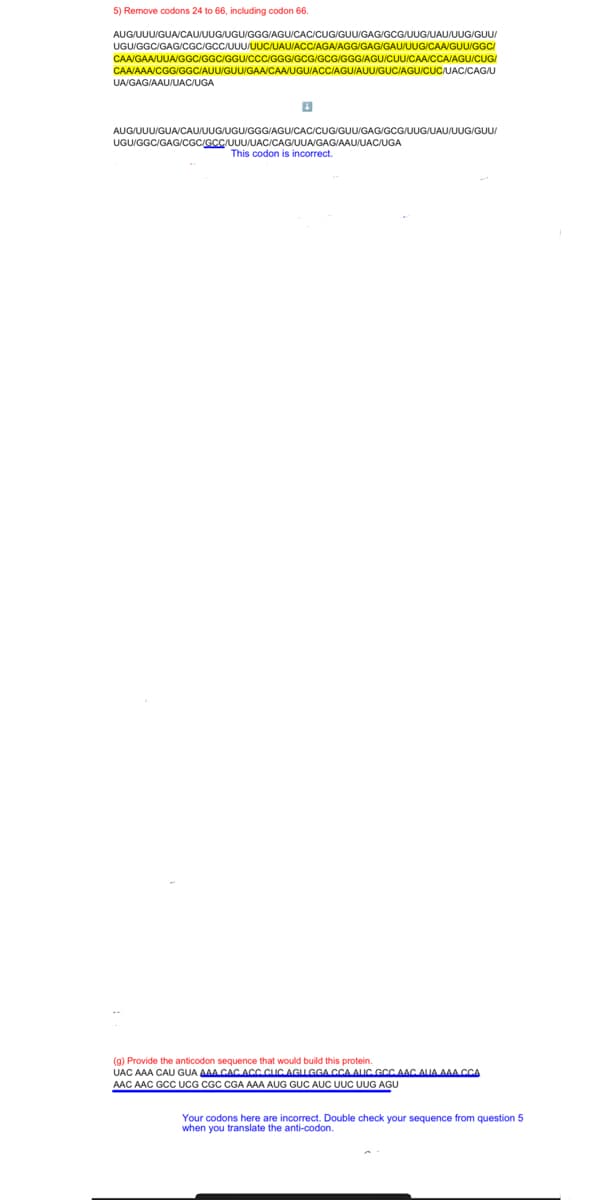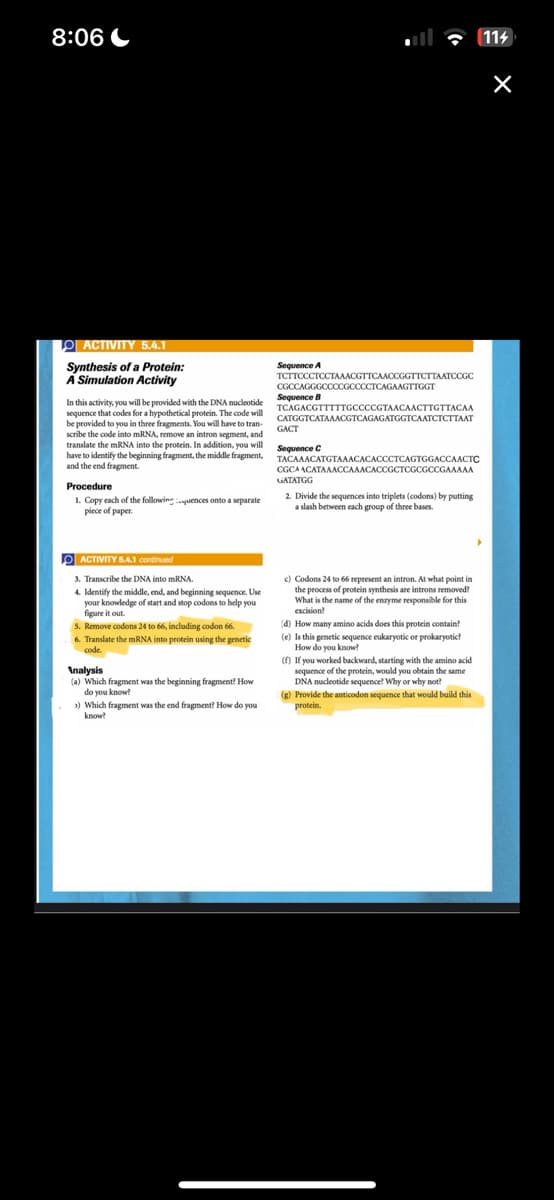5) Remove codons 24 to 66, including codon 66. AUG/UUU/GUA/CAU/UUG/UGU/GGG/AGU/CAC/CUG/GUU/GAG/GCG/UUG/UAU/UUG/GUU/ UGU/GGC/GAG/CGC/GCC/UUU/UUC/UAU/ACC/AGA/AGG/GAG/GAU/UUG/CAA/GUU/GGC/ CAA/GAA/UUA/GGC/GGC/GGU/CCC/GGG/GCG/GCG/GGG/AGU/CUU/CAA/CCA/AGU/CUG/ CAA/AAA/CGG/GGC/AUU/GUU/GAA/CAA/UGU/ACC/AGU/AUU/GUC/AGU/CUC/UAC/CAG/U UA/GAG/AAU/UAC/UGA AUG/UUU/GUA/CAU/UUG/UGU/GGG/AGU/CAC/CUG/GUU/GAG/GCG/UUG/UAU/UUG/GUU/ UGU/GGC/GAG/CGC/GCC/UUU/UAC/CAG/UUA/GAG/AAU/UAC/UGA This codon is incorrect. (g) Provide the anticodon sequence that would build this protein. UAC AAA CAU CUA BAA CÁC ACC CUC AGLLGGA CỦA ALIC GCC AAC ALIA AAA CỦA AAC AAC GCC UCG CGC CGA AAA AUG GUC AUC UUC UUG AGU Your codons here are incorrect. Double check your sequence from question 5 when you translate the anti-codon. 8:06 114 ACTIVITY 5.4.1 Synthesis of a Protein: A Simulation Activity In this activity, you will be provided with the DNA nucleotide sequence that codes for a hypothetical protein. The code will be provided to you in three fragments. You will have to tran- scribe the code into mRNA, remove an intron segment, and translate the mRNA into the protein. In addition, you will Sequence A TCTTCCCTCCTAAACGTTCAACCGGTTCTTAATCCGC CGCCAGGGCCOCGCCCCTCAGAAGTTGGT Sequence B TCAGACGTTTTTGCCCCGTAACAACTTGTTACAA CATGGTCATAAACGTCAGAGATGGTCAATCTCTTAAT GACT Sequence C have to identify the beginning fragment, the middle fragment, TACAAACATGTAAACACACCCTCAGTGGACCAACTC and the end fragment. Procedure 1. Copy each of the followingquences onto a separate piece of paper. CGCA ACATAAACCAAACACCGCTCGCGCCGAAAAA GATATGG 2. Divide the sequences into triplets (codons) by putting a slash between each group of three bases. ACTIVITY 5.4.1 continued 3. Transcribe the DNA into mRNA. 4. Identify the middle, end, and beginning sequence. Use your knowledge of start and stop codons to help you figure it out. 5. Remove codons 24 to 66, including codon 66. 6. Translate the mRNA into protein using the genetic code. Analysis (a) Which fragment was the beginning fragment? How do you know? >) Which fragment was the end fragment? How do you know? c) Codons 24 to 66 represent an intron. At what point in the process of protein synthesis are introns removed? What is the name of the enzyme responsible for this excision? (d) How many amino acids does this protein contain? (e) Is this genetic sequence eukaryotic or prokaryotic? How do you know? (f) If you worked backward, starting with the amino acid sequence of the protein, would you obtain the same DNA nucleotide sequence? Why or why not? (g) Provide the anticodon sequence that would build this protein.
5) Remove codons 24 to 66, including codon 66. AUG/UUU/GUA/CAU/UUG/UGU/GGG/AGU/CAC/CUG/GUU/GAG/GCG/UUG/UAU/UUG/GUU/ UGU/GGC/GAG/CGC/GCC/UUU/UUC/UAU/ACC/AGA/AGG/GAG/GAU/UUG/CAA/GUU/GGC/ CAA/GAA/UUA/GGC/GGC/GGU/CCC/GGG/GCG/GCG/GGG/AGU/CUU/CAA/CCA/AGU/CUG/ CAA/AAA/CGG/GGC/AUU/GUU/GAA/CAA/UGU/ACC/AGU/AUU/GUC/AGU/CUC/UAC/CAG/U UA/GAG/AAU/UAC/UGA AUG/UUU/GUA/CAU/UUG/UGU/GGG/AGU/CAC/CUG/GUU/GAG/GCG/UUG/UAU/UUG/GUU/ UGU/GGC/GAG/CGC/GCC/UUU/UAC/CAG/UUA/GAG/AAU/UAC/UGA This codon is incorrect. (g) Provide the anticodon sequence that would build this protein. UAC AAA CAU CUA BAA CÁC ACC CUC AGLLGGA CỦA ALIC GCC AAC ALIA AAA CỦA AAC AAC GCC UCG CGC CGA AAA AUG GUC AUC UUC UUG AGU Your codons here are incorrect. Double check your sequence from question 5 when you translate the anti-codon. 8:06 114 ACTIVITY 5.4.1 Synthesis of a Protein: A Simulation Activity In this activity, you will be provided with the DNA nucleotide sequence that codes for a hypothetical protein. The code will be provided to you in three fragments. You will have to tran- scribe the code into mRNA, remove an intron segment, and translate the mRNA into the protein. In addition, you will Sequence A TCTTCCCTCCTAAACGTTCAACCGGTTCTTAATCCGC CGCCAGGGCCOCGCCCCTCAGAAGTTGGT Sequence B TCAGACGTTTTTGCCCCGTAACAACTTGTTACAA CATGGTCATAAACGTCAGAGATGGTCAATCTCTTAAT GACT Sequence C have to identify the beginning fragment, the middle fragment, TACAAACATGTAAACACACCCTCAGTGGACCAACTC and the end fragment. Procedure 1. Copy each of the followingquences onto a separate piece of paper. CGCA ACATAAACCAAACACCGCTCGCGCCGAAAAA GATATGG 2. Divide the sequences into triplets (codons) by putting a slash between each group of three bases. ACTIVITY 5.4.1 continued 3. Transcribe the DNA into mRNA. 4. Identify the middle, end, and beginning sequence. Use your knowledge of start and stop codons to help you figure it out. 5. Remove codons 24 to 66, including codon 66. 6. Translate the mRNA into protein using the genetic code. Analysis (a) Which fragment was the beginning fragment? How do you know? >) Which fragment was the end fragment? How do you know? c) Codons 24 to 66 represent an intron. At what point in the process of protein synthesis are introns removed? What is the name of the enzyme responsible for this excision? (d) How many amino acids does this protein contain? (e) Is this genetic sequence eukaryotic or prokaryotic? How do you know? (f) If you worked backward, starting with the amino acid sequence of the protein, would you obtain the same DNA nucleotide sequence? Why or why not? (g) Provide the anticodon sequence that would build this protein.
Biochemistry
6th Edition
ISBN:9781305577206
Author:Reginald H. Garrett, Charles M. Grisham
Publisher:Reginald H. Garrett, Charles M. Grisham
Chapter30: Protein Synthesis
Section: Chapter Questions
Problem 2P
Question
make sure it’s correct

Transcribed Image Text:5) Remove codons 24 to 66, including codon 66.
AUG/UUU/GUA/CAU/UUG/UGU/GGG/AGU/CAC/CUG/GUU/GAG/GCG/UUG/UAU/UUG/GUU/
UGU/GGC/GAG/CGC/GCC/UUU/UUC/UAU/ACC/AGA/AGG/GAG/GAU/UUG/CAA/GUU/GGC/
CAA/GAA/UUA/GGC/GGC/GGU/CCC/GGG/GCG/GCG/GGG/AGU/CUU/CAA/CCA/AGU/CUG/
CAA/AAA/CGG/GGC/AUU/GUU/GAA/CAA/UGU/ACC/AGU/AUU/GUC/AGU/CUC/UAC/CAG/U
UA/GAG/AAU/UAC/UGA
AUG/UUU/GUA/CAU/UUG/UGU/GGG/AGU/CAC/CUG/GUU/GAG/GCG/UUG/UAU/UUG/GUU/
UGU/GGC/GAG/CGC/GCC/UUU/UAC/CAG/UUA/GAG/AAU/UAC/UGA
This codon is incorrect.
(g) Provide the anticodon sequence that would build this protein.
UAC AAA CAU CUA BAA CÁC ACC CUC AGLLGGA CỦA ALIC GCC AAC ALIA AAA CỦA
AAC AAC GCC UCG CGC CGA AAA AUG GUC AUC UUC UUG AGU
Your codons here are incorrect. Double check your sequence from question 5
when you translate the anti-codon.

Transcribed Image Text:8:06
114
ACTIVITY 5.4.1
Synthesis of a Protein:
A Simulation Activity
In this activity, you will be provided with the DNA nucleotide
sequence that codes for a hypothetical protein. The code will
be provided to you in three fragments. You will have to tran-
scribe the code into mRNA, remove an intron segment, and
translate the mRNA into the protein. In addition, you will
Sequence A
TCTTCCCTCCTAAACGTTCAACCGGTTCTTAATCCGC
CGCCAGGGCCOCGCCCCTCAGAAGTTGGT
Sequence B
TCAGACGTTTTTGCCCCGTAACAACTTGTTACAA
CATGGTCATAAACGTCAGAGATGGTCAATCTCTTAAT
GACT
Sequence C
have to identify the beginning fragment, the middle fragment, TACAAACATGTAAACACACCCTCAGTGGACCAACTC
and the end fragment.
Procedure
1. Copy each of the followingquences onto a separate
piece of paper.
CGCA ACATAAACCAAACACCGCTCGCGCCGAAAAA
GATATGG
2. Divide the sequences into triplets (codons) by putting
a slash between each group of three bases.
ACTIVITY 5.4.1 continued
3. Transcribe the DNA into mRNA.
4. Identify the middle, end, and beginning sequence. Use
your knowledge of start and stop codons to help you
figure it out.
5. Remove codons 24 to 66, including codon 66.
6. Translate the mRNA into protein using the genetic
code.
Analysis
(a) Which fragment was the beginning fragment? How
do you know?
>) Which fragment was the end fragment? How do you
know?
c) Codons 24 to 66 represent an intron. At what point in
the process of protein synthesis are introns removed?
What is the name of the enzyme responsible for this
excision?
(d) How many amino acids does this protein contain?
(e) Is this genetic sequence eukaryotic or prokaryotic?
How do you know?
(f) If you worked backward, starting with the amino acid
sequence of the protein, would you obtain the same
DNA nucleotide sequence? Why or why not?
(g) Provide the anticodon sequence that would build this
protein.
Expert Solution
This question has been solved!
Explore an expertly crafted, step-by-step solution for a thorough understanding of key concepts.
Step by step
Solved in 2 steps

Recommended textbooks for you

Biochemistry
Biochemistry
ISBN:
9781305577206
Author:
Reginald H. Garrett, Charles M. Grisham
Publisher:
Cengage Learning

Biology 2e
Biology
ISBN:
9781947172517
Author:
Matthew Douglas, Jung Choi, Mary Ann Clark
Publisher:
OpenStax

Anatomy & Physiology
Biology
ISBN:
9781938168130
Author:
Kelly A. Young, James A. Wise, Peter DeSaix, Dean H. Kruse, Brandon Poe, Eddie Johnson, Jody E. Johnson, Oksana Korol, J. Gordon Betts, Mark Womble
Publisher:
OpenStax College

Biochemistry
Biochemistry
ISBN:
9781305577206
Author:
Reginald H. Garrett, Charles M. Grisham
Publisher:
Cengage Learning

Biology 2e
Biology
ISBN:
9781947172517
Author:
Matthew Douglas, Jung Choi, Mary Ann Clark
Publisher:
OpenStax

Anatomy & Physiology
Biology
ISBN:
9781938168130
Author:
Kelly A. Young, James A. Wise, Peter DeSaix, Dean H. Kruse, Brandon Poe, Eddie Johnson, Jody E. Johnson, Oksana Korol, J. Gordon Betts, Mark Womble
Publisher:
OpenStax College

Biology: The Dynamic Science (MindTap Course List)
Biology
ISBN:
9781305389892
Author:
Peter J. Russell, Paul E. Hertz, Beverly McMillan
Publisher:
Cengage Learning